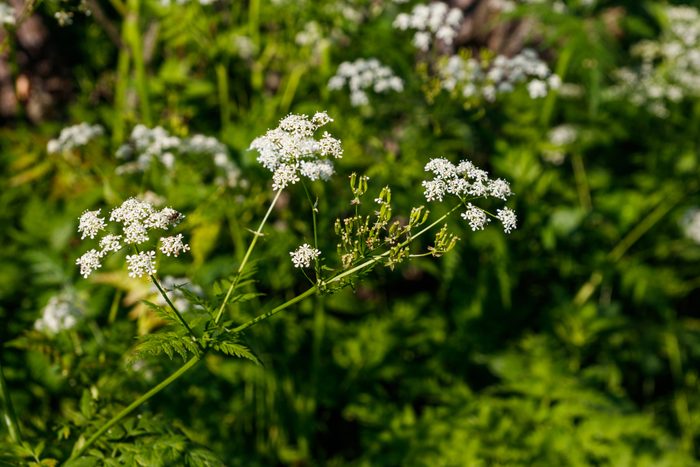Why Is Poison Hemlock So Dangerous?

Poison hemlock is becoming more prolific in parts of the United States. Here's how to recognize and get rid of this potentially deadly plant.
Poison hemlock is a plant of legend and infamy. While it’s a favorite weapon for murder mystery writers, its most recognized use was in the forced suicide of a well-known Greek philosopher in 399 B.C.
“Poison hemlock is the famed plant that killed Socrates,” says Em Shipman, executive director of KidsGardening.org. “Treat this plant with respect and take careful steps to eradicate it.”
Many people seriously harmed by poison hemlock mistook it for an edible plant, like parsnip or parsley. But even if you aren’t out foraging, it’s important to learn how to identify it and teach children to recognize it, because it can be noxious in other ways.
On This Page
What Is Hemlock?
Poison hemlock (Conium maculatum) — AKA poison parsley, European hemlock, spotted hemlock, deadly hemlock, California or Nebraska fern and devil’s porridge — is a large, invasive, noxious weed. It’s not the same thing as hemlock trees, which are not poisonous.
In the 1800s poison hemlock jumped from Europe to the U.S. when people started importing it as an ornamental garden plant. Now it’s found in every state as well as southern Canada. Most often it grows along roadsides, the edges of fields and small waterways. Recently, its territory expanded into rangelands and more populated areas, causing greater concern.
Although it’s in the same plant family as carrots and dill, every part of it is poisonous. It’s a biennial plant, which means it has a two-year lifespan and flowers only in its second year. After flowering, it can produce more than 35,000 seeds, which are spread easily by water and animals. The seeds can stay viable for six years.
Is Hemlock Poisonous?
Absolutely, hence its name. Hemlock contains acutely toxic alkaloids including coniine, which is poisonous to all mammals and many other organisms.
Coniine, also found in dog parsley (Aethusa cynapium), has structural and chemical properties similar to nicotine. It targets the central nervous system.
Symptoms show up between 20 minutes and three hours after ingestion, and can include pupil dilation, dizziness, trembling and difficulty walking. That can be followed by a slowed heart rate and paralysis of muscles or the central nervous system, which can lead to death from respiratory failure.
Ingesting hemlock is the most dangerous type of exposure, but every part is poisonous, especially the seeds. Touching it can lead to severe skin irritation, and inhaling air near mowed hemlock can cause respiratory irritation. Even dead plant canes can be poisonous for up to three years.
It’s also poisonous and potentially deadly to pets and livestock. Their symptoms can be similar to humans, but also include nervous trembling, salivation, lack of coordination and a rapid or weak pulse.
If you suspect you’ve been exposed, call 911 or poison control (800-222-1222) immediately. With swift action, people can usually be successfully treated in a hospital.
What Does Poison Hemlock Look Like?
Poison hemlock is a tall, ferny-leafed plant, topped with three-to-six-inch umbrella-like clusters of small, white flowers. Its stalks are smooth and hollow, freckled with purple spots and streaks.
“The plants are usually low-growing in their first year but can reach six to 10 feet in their second year,” says Shipman. “Wild hemlock also produces abundant seeds and readily spreads, forming dense stands.”
Poison hemlock looks similar to wild carrot, AKA Queen Anne’s lace, but often grows taller. To tell them apart, look at the leaves and stalks.
Wild carrot has somewhat hairy green stems and leaves. Hemlock stems and leaves are smooth, even shiny-looking, and often have at least a little red or purple spotting on them. On wild carrots, each flower stem has one main flower cluster with a dark-purple flower in the center, whereas hemlock has branched stems with many flower clusters.
Hemlock can also have an unpleasant musty smell.
How To Get Rid of Poison Hemlock
“Keep a lookout for it so you can control small infestations before they spread,” says Shipman. “And practice extreme caution when dealing with poison hemlock.”
- Wear protective clothing. Whenever you’re going to handle poison hemlock, wear long sleeves, pants, socks, gloves and a mask.
- Mow it. If you can get to it before or just after it starts to flower, that will prevent seeds from forming.
- Mow again. Repeated mowing will remove new growth and deplete the roots’ energy reserves.
- Dig up and hand-pull seedlings as they sprout.
- Take frequent breaks to check for signs of exposure.
- Throw plants in the trash. Don’t put them in the compost, as the toxins in dead plants can persist for several years. And definitely don’t burn them; the fumes can cause serious injury if inhaled.
- Clean. Carefully wash your equipment, shoes, clothes and hands after mowing.
- Don’t use herbicides, which aren’t effective on large plants.
If you need more help identifying poison hemlock or figuring out the best ways to get rid of it, ask your local university cooperative extension. Your local agricultural extension office might also be willing to help you remove it.



